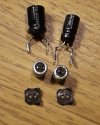It looks like this one needs a new 5V chip. Input supply is 5.81V, but the feedback control pin is only 0.77V when it would be 1.25V if regulating correctly.I agree. I can see that if the SM cap is leaking a tiny bit of current then the FET might not have enough gate volts to turn on fully, and then higher peak demand on the FET by a busy HD could cause a problem.
I don't have the right tools to hand to guarantee success and just tagging it "seems" to work. But the second machine I fixed has died again while on soak test so I thought I'd do as you recommended, and since it is only a spare what have I got to lose?
First pic is with SM cap removed, phew, and next pic is with another new 4.7uF leaded cap.
But... I should have checked all the supplies to the HD first because the +5V is missing, while the +12V is switching OK. Both are OK leaving the PSU card, so I need to find the +5V control chip. I remember it has been mentioned in this thread. Off for a look.
It looks tricky to remove without also removing the plastic HDD power plug so close. I need to buy more gas for my pyropen.
I may be some time fixing this one.







